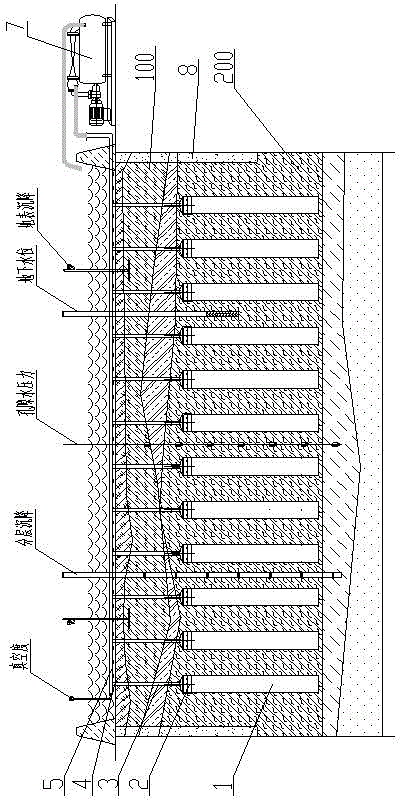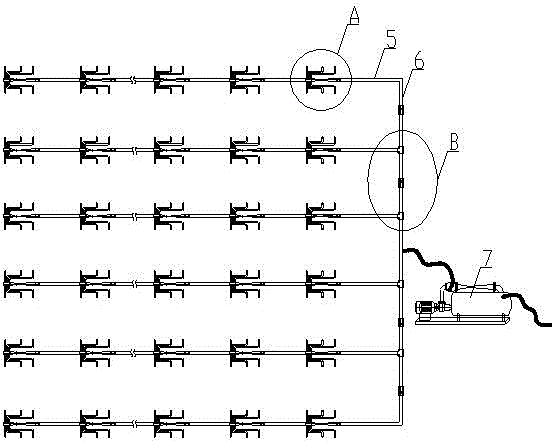Vacuum prepressing seepage consolidation method
A vacuum and preloading technology, applied in infrastructure engineering, soil protection, construction, etc., can solve problems such as difficulty in finding air leaks, need for sealing film, and non-environmental protection of pvc sealing film, so as to achieve good construction effect and reduce impact , low cost effect
- Summary
- Abstract
- Description
- Claims
- Application Information
AI Technical Summary
Problems solved by technology
Method used
Image
Examples
Embodiment 1
[0101] Basic information before foundation treatment:
[0102] The third layer of muddy clay layer of the foundation has a water content of 55%, a compressive modulus of 2.3MPa, an average layer thickness of 15 meters, a buried depth of 5 meters at the top of the layer, and a buried depth of 20 meters at the bottom.
[0103] Implementation steps:
[0104] Step 1. The site is leveled, and drainage ditches are excavated around the area to be reinforced;
[0105] Step 2. Pre-tamping, energy level 800kN.m, square tamping point spacing 4m*4m, after tamping, construct cement mixing pile lateral sealing retaining wall or mud lateral sealing retaining wall;
[0106] Step 3. Arrangement of integrated well point plastic exhaust vacuum system
[0107] 3.1. The integrated well point plastic pipe is inserted and constructed to form an integrated well point plastic pipe grid;
[0108] The grid spacing of the integrated well point plastic pipe grid is 1.2m, and the insertion depth of the ...
Embodiment 2
[0124] Basic information before foundation treatment
[0125] The fourth silty clay layer of the foundation has a water content of 38%, a compressive modulus of 3.8 MPa, an average thickness of 13 meters, a buried depth of 3 meters at the top of the layer, and a buried depth of 16 meters at the bottom of the layer.
[0126] Step 1. The site is leveled, and drainage ditches are excavated around the area to be reinforced;
[0127] Step 2. Do not carry out pre-tamping before precipitation, and construct lateral sealing retaining wall of cement mixing pile or lateral sealing retaining wall of mud;
[0128] Step 3. Arrangement of integrated well point plastic exhaust vacuum system
[0129] 3.1. The integrated well point plastic pipe is inserted and constructed to form an integrated well point plastic pipe grid;
[0130] The grid spacing of the integrated well point plastic pipe grid is 1.5m, and the insertion depth of the integrated well point pipe is 16m
[0131] The length of ...
Embodiment 3
[0146] Basic information before foundation treatment
[0147] The silty clay in the second layer of the foundation has a water content of 78%, a compressive modulus of 2.1 MPa, an average thickness of 20 meters, a buried depth of 4 meters at the top of the layer, and a buried depth of 24 meters at the bottom of the layer.
[0148] Step 1. The site is leveled, and drainage ditches are excavated around the reinforcement area;
[0149] Step 2. Pre-tamping before precipitation, energy level 600kN.m, square tamping point spacing 4m*7m, after tamping, construct cement mixing pile lateral sealing retaining wall or mud lateral sealing retaining wall;
[0150] Step 3. Arrangement of integrated well point plastic exhaust vacuum system
[0151] 3.1. The integrated well point plastic pipe is inserted and constructed to form an integrated well point plastic pipe grid;
[0152] The grid spacing of the integrated well point plastic pipe grid is 1.0m, and the insertion depth of the integrat...
PUM
| Property | Measurement | Unit |
|---|---|---|
| Bearing capacity of foundation | aaaaa | aaaaa |
| Compression modulus | aaaaa | aaaaa |
| Compression modulus | aaaaa | aaaaa |
Abstract
Description
Claims
Application Information
 Login to View More
Login to View More - R&D
- Intellectual Property
- Life Sciences
- Materials
- Tech Scout
- Unparalleled Data Quality
- Higher Quality Content
- 60% Fewer Hallucinations
Browse by: Latest US Patents, China's latest patents, Technical Efficacy Thesaurus, Application Domain, Technology Topic, Popular Technical Reports.
© 2025 PatSnap. All rights reserved.Legal|Privacy policy|Modern Slavery Act Transparency Statement|Sitemap|About US| Contact US: help@patsnap.com



